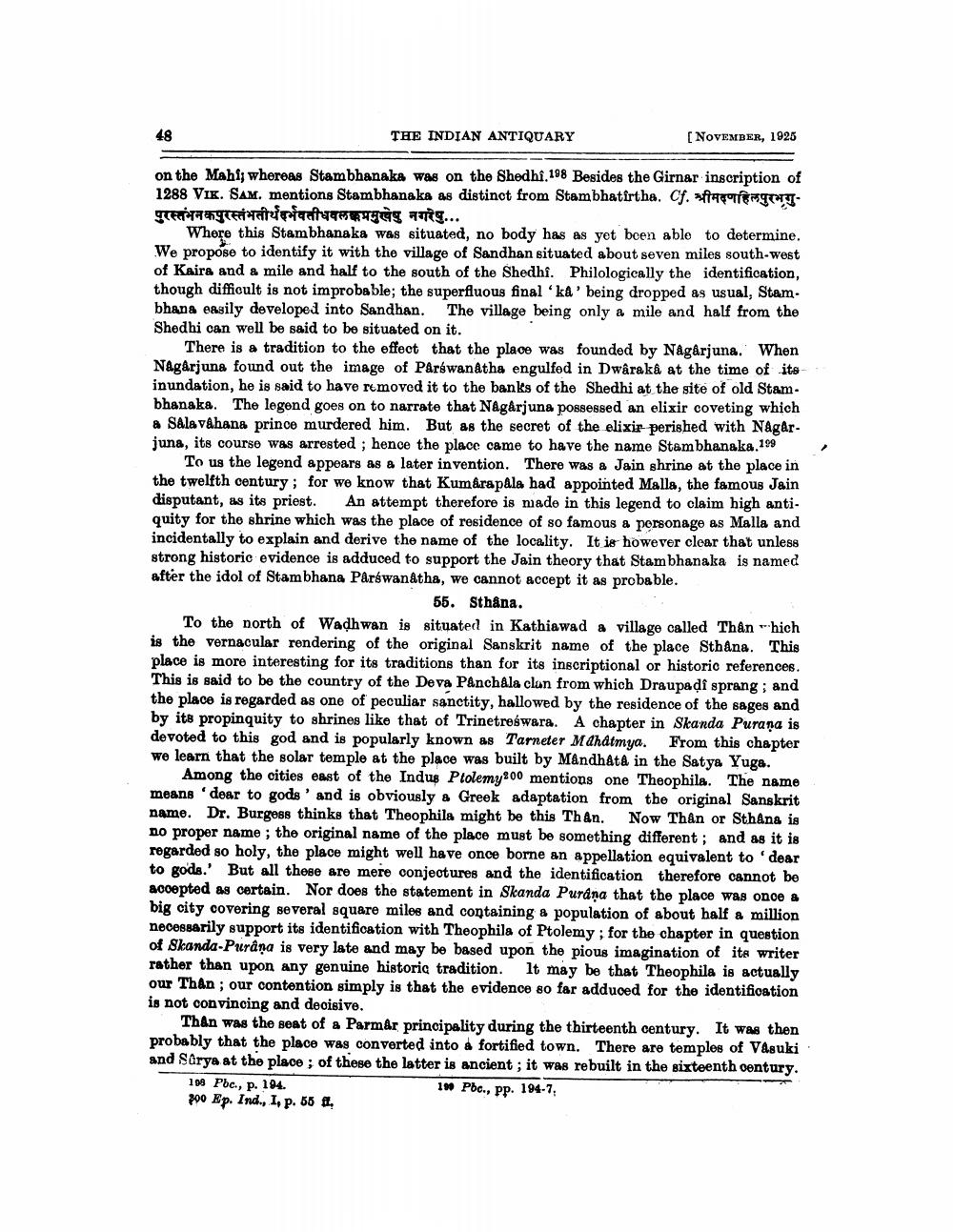________________
48
THE INDIAN ANTIQUARY
(NOVEMBER, 1925
on the Mahi; whereas Stambhanaka was on the Shedhi.198 Besides the Girnar inscription of 1288 VIK. SAM, mentions Stambhanaka as distinct from Stambhatirtha. Cf. CHITHT पुरस्तंभनकपुरस्तंभतीर्थदर्भवतीधवलक्कप्रमुखेषु नगरेषु...
Whore this Stambhanaka was situated, no body has as yet been able to determine. We propose to identify it with the village of Sandhan situated about seven miles south-west of Kairs and & mile and half to the south of the Shedhi. Philologically the identification, though difficult is not improbable; the superfluous final 'ka' being dropped as usual, Stam. bhana easily developed into Sandhan. The village being only a mile and half from the Shodhi can well be said to be situated on it.
There is a tradition to the effect that the place was founded by Nagarjuna. When Nagarjuna found out the image of Parswanatha engulfed in Dwaraka at the time of its inundation, he is said to have removed it to the banks of the Shedhi at the site of old Stam. bhanaka. The legend goes on to narrate that Nagarjuna possessed an elixir coveting which a Sala vahana prince murdered him. But as the secret of the elixir perished with Nagarjuna, its course was arrested ; hence the place came to have the name Stambhanaka.199
To us the legend appears as a later invention. There was a Jain shrine at the place in the twelfth century; for we know that Kumarapala had appointed Malla, the famous Jain disputant, as its priest. An attempt therefore is made in this legend to claim high antiquity for the shrine which was the place of residence of so famous a personage as Malla and incidentally to explain and derive the name of the locality. It is however clear that unless strong historic evidence is adduced to support the Jain theory that Stambhanaka is named after the idol of Stambhana Parswanatha, we cannot accept it as probable.
55. Sthana. To the north of Wadhwan is situated in Kathiawad a village called Than which is the vernacular rendering of the original Sanskrit name of the place Sthana. This place is more interesting for its traditions than for its inscriptional or historio references. This is said to be the country of the Deva Panchala clun from which Draupadi sprang; and the place is regarded as one of peculiar sanctity, hallowed by the residence of the sages and by its propinquity to shrines like that of Trinetreswara. A chapter in Skanda Purana is devoted to this god and is popularly known as Tarneter Mahatmya. From this chapter we learn that the solar temple at the place was built by Mandhata in the Satya Yuga.
Among the cities east of the Indus Ptolemy200 mentions one Theophila. The name means 'dear to gods' and is obviously & Greek adaptation from the original Sanskrit name. Dr. Burgess thinks that Theophila might be this Than. Now Than or Sthana is no proper name; the original name of the place must be something different; and as it is regarded so holy, the place might well have once borne an appellation equivalent to 'dear to gods.' But all these are mere oonjectures and the identification therefore cannot be accepted as certain. Nor does the statement in Skanda Purana that the place was once a big city covering several square miles and containing & population of about half a million necessarily support its identification with Theophila of Ptolemy; for the chapter in question of Skanda-Purâna is very late and may be based upon the pious imagination of its writer rather than upon any genuine historia tradition. It may be that Theophila is actually our Than ; our contention simply is that the evidence so far adduced for the identifioation is not convincing and decisive.
Than was the seat of a Parmar principality during the thirteenth century. It was then probably that the place was converted into a fortified town. There are temples of Vasuki and Sorya at the place ; of these the latter is ancient; it was rebuilt in the sixteenth century. 109 Pbc., p. 194.
19 Pbc., pp. 194-7, 200 Ep. Ind., I, p. 58 ft.




